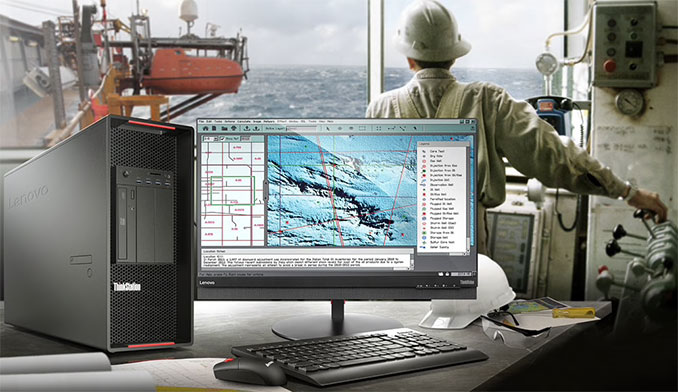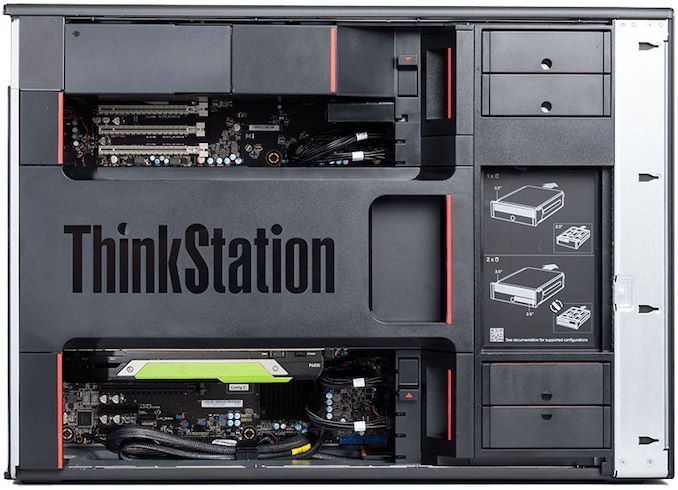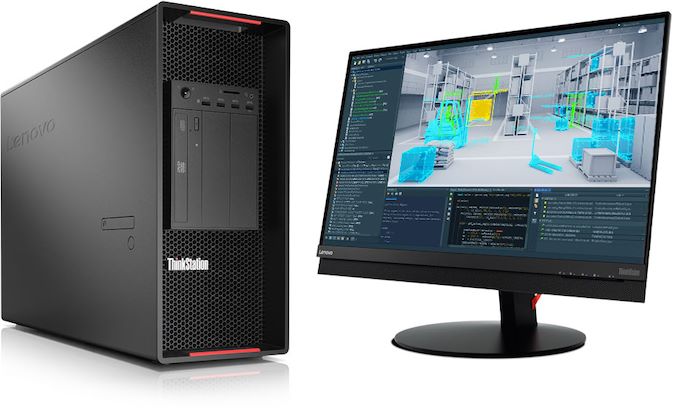Lenovo Unveils ThinkStation P520 & P920 ‘AI Workstations’: Xeon Plus Quadro RTX 6000
by Anton Shilov on March 7, 2019 11:00 AM EST- Posted in
- Workstations
- Intel
- Lenovo
- Xeon
- NVIDIA
- ThinkStation
- Quadro RTX
- Turing

Lenovo this week has introduced its new single and dual-processor “AI Workstations”, which the company is pitching at the artificial intelligence and deep learning markets. The new machines are based on the existing ThinkStation P520 and ThinkStation P920 workstations, and are powered by Intel’s Xeon processors as well as one or two of NVIDIA’s latest Quadro RTX 6000 professional graphics cards.
The Lenovo AI Workstation lineup consists of two systems which specs are tailored for AI, DL, and similar workloads, according to the manufacturer. The systems can additionally be clustered together using Lenovo's Intelligent Computing Orchestration (LiCO) software to further improve their aggregate performance at both the desktop and datacenter levels. Both new ThinkStation machines run Ubuntu Linux, which in a departure from the usual PC desktop situation, is actually far more common than Windows when it comes to deep learning work. Besides the usual *nix synergies, a big reason for this is because Ubuntu Linux is the only OS currently recommended by NVIDIA for its popular RAPIDS open source software libraries, which are widely used in analytics and data science tasks.
Under the hood, the new ThinkStation P520 AI Workstation is powered by Intel's Xeon W-2155 processor (10/20 cores/threads, 3.3 – 4.5 GHz, 13.75 MB L3, 140 W) and paired with NVIDIA’s Quadro RTX 6000 graphics card (4,608 cores, 576 tensor cores, 72 RT cores, 16.3 FP32 TFLOPS, 24 GB GDDR4). The system is outfitted with 128 GB of DDR4-2666 ECC memory, a 512 GB NVMe SSD, as well two 1 TB 2.5-inch SATA SSDs.
Meanwhile the ThinkStation P920 AI Workstation is an inherently more powerful machine. It runs two Intel Xeon Gold 6136 chips (12/24 cores/threads, 3 – 3.7 GHz, 24.75 MB L3, 150 W) accompanied by a pair of NVIDIA’s Quadro RTX 6000 accelerators. The workstation comes equipped with 384 GB of DDR4-2666 ECC memory, 1 TB NVMe SSD, and two 2 TB 2.5-inch SATA SSDs.
| Lenovo ThinkStation P520 & P920 AI Workstation Specs | |||
| ThinkStation P520 AI Workstation |
ThinkStation P920 AI Workstation |
||
| CPU | Intel Xeon W-2155 10/20 cores/threads 3.3 - 4.5 GHz 13.75 MB L3 140 W |
2 × Intel Xeon Gold 6136 2 × 12/24 cores/threads 2 × 3 - 3.7 GHz 2 × 24.75 MB L3 2 × 150 W |
|
| GPU | NVIDIA Quadro RTX 6000 TU102 4,608 cores 576 tensor cores 72 RT cores 24 GB GDDR4 |
2 × NVIDIA Quadro RTX 6000 | |
| RAM | 128 GB (8 × 16 GB) DDR4-2666 | 384 GB (12 × 32 GB) DDR4-2666 | |
| Boot Storage | 512 GB NVMe SSD | 1 TB GB NVMe SSDs | |
| Data Storage | 2 × 1 TB SATA SSDs | 2 × 2 TB SATA SSDs | |
| OS | Ubuntu Linux | ||
Both of new ThinkStation systems are also available with further customizations as a build-to-order operation, allowing for more storage and other tweaks. Lenovo says that the new systems will be available by the end of March, and while their press release does not reveal any pricing information, these professional systems won't be cheap. As they're based on Lenovo's high-end workstation platforms, the P920 AI Workstation in particular will easily be a $10,000+ machine.
Related Reading:
- Lenovo Updates ThinkStation P320 with Intel Xeon E3 v6 and NVIDIA Quadro Pascal
- Lenovo Unveils ThinkStation P320 Tiny SFF Workstation
- Lenovo Unveils ThinkStation P410/P510: Intel Xeon E5 v4 with Up to 8 Cores, NVIDIA Quadro M6000
Source: Lenovo












15 Comments
View All Comments
p1esk - Thursday, March 7, 2019 - link
Titan RTX ($2,500) has the same specs as Quadro RTX 6000 ($4,000), the only difference is ECC support, which is irrelevant for DL tasks.p1esk - Thursday, March 7, 2019 - link
Also, for running DL models you don't need dual CPUs unless you have 8 GPU cards. Finally, Threadripper 2950X provides much better price/performance ratio than either of those Xeons.HStewart - Thursday, March 7, 2019 - link
No a Threadripper 2950X core does not have the performance of Xeon Gold 12/24 - because Intel has at least 50% more performance per core than AMD, plus there is two Xeons. Plus you can go up to 28/56 Xeon - and this does not even take account these are Engineering computers and likely will use AVX 512,kgardas - Thursday, March 7, 2019 - link
Intel to have 50% more performance per core than AMD? Any benchmark as a reference for this claim? I would find it unbelievable especially with OS/BIOS/microcode patched to fix Intel's vulnerabilities...HStewart - Thursday, March 7, 2019 - link
Well that is an estimate and depends on which test - but equal amount cores performance are significantly higher on Intel. Also keep in mind these are new Xeon and they have the Vulnerabilities fix in hardware in a lot of cases.I didn't find 6136 in comparison - but I did find 6154 - but keep in mind the 6136 is a year old cpu and in Lenovo setup will have two of them.
https://technical.city/en/cpu/Xeon-Gold-6154-vs-Ry...
But if you include AVX 512 in picture, Threadripper has no chance of all.
lazarpandar - Thursday, March 7, 2019 - link
p1esk said "price to performance" which the link you posted clearly shows. Those benchmarks show a $900 chip performing almost as well as a $3800 chip. AMD is the clear winner in price to performance, which means Intel is only relevant in the most expensive bracket. AMD chips demolish Intel chips at the same prices.HStewart - Thursday, March 7, 2019 - link
There is a lot more than just x86-64 instructions that make it up a CPU. Xeons have AVX-512 bit while last I heard that AMD has 2 128bit combine together for make AVX2. There are other abilities in that AMD chips don't have like support up to 4 CPU';skobblestown - Friday, March 8, 2019 - link
You shouldn't be looking at features in isolation. Yes, Zen is underpowered in the FP departament, but it's still holding up pretty well. And with Zen 2 they will double the DP throughput. And while AVX-512 double the theoretical throughput it also brings (1) down the clock rate and (2) needs software written with AVX-512 in mind to make use of it. Also, Ryzen processors generally have core count advantage at the same price which will compensates for the lower FP throughput. The core count advantage will probably get even bigger with Zen2 - 16cores for the desktop and 64 cores for HEDT! Although I don't claim they will have these core counts at launch. Why do it, when intel cannot come even close. Better to roast them slowly.As for 4 socket configurations - how many cores can you fit in this way. I'd assume it's like 4x28 =112. With Epyc 2 you will be able to get 2x64=128. You'll have less memory bandwidth 4x6 vs 2*8 but how bad that hurts will depend on the actual workload. There's one thing you can be certain about - it will cost you a small fraction of the cost for intel's 4 socket configs.
But really, my favorite is the Threadripper platform. Last year I got the 12 core TR1920X + Asrock X399 with 10G Ethernet adapter on board for 700 UK pounds total. Total! And I have 3xM.2 NVME slots + 2xPCIex16 + 2xPCIex8 and you can use them all in their full capacity. Plus a 4-wide memory controller that supports ECC. And either this year or a bit later down the road I will be able to replace the CPU with a 64 core beast. Damn, I can plug in a 32-core one right now if I need (and I'm mostly running Linux so I won't be hurt by the inadequate CPU scheduler in Windows). Really, for my money, intel do not exist at the moment.
fallaha56 - Friday, March 8, 2019 - link
great summarycompletely agree
Intel HEDT at the moment is a waste of $$$
you can of course add to your comments that Zen5 will be drop in for Threadripper also
olafgarten - Thursday, March 7, 2019 - link
Depends what type of DL you are doing Reinforcement Learning is very CPU heavy as a lot of environments don't lend themselves to GPU simulation.